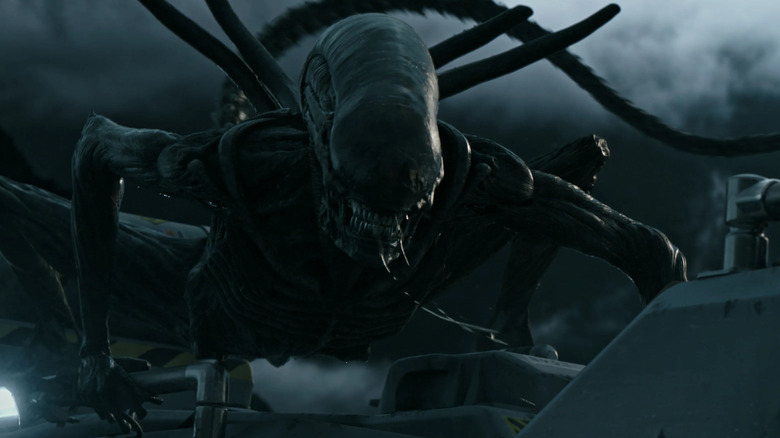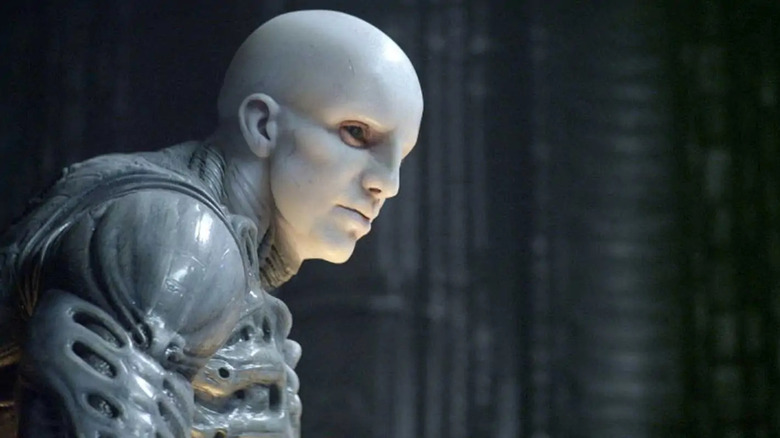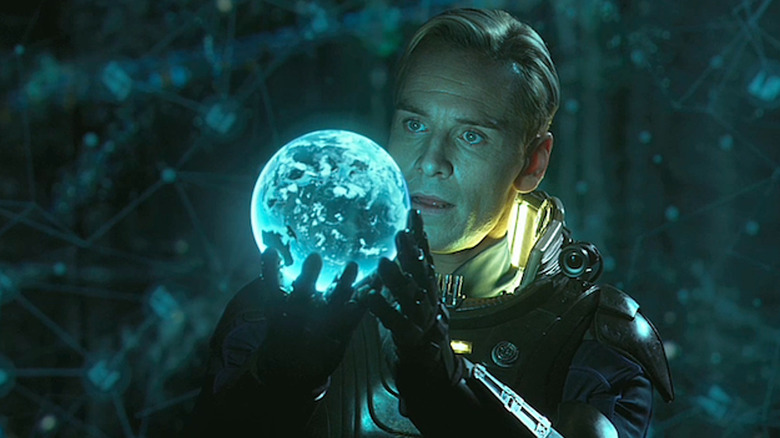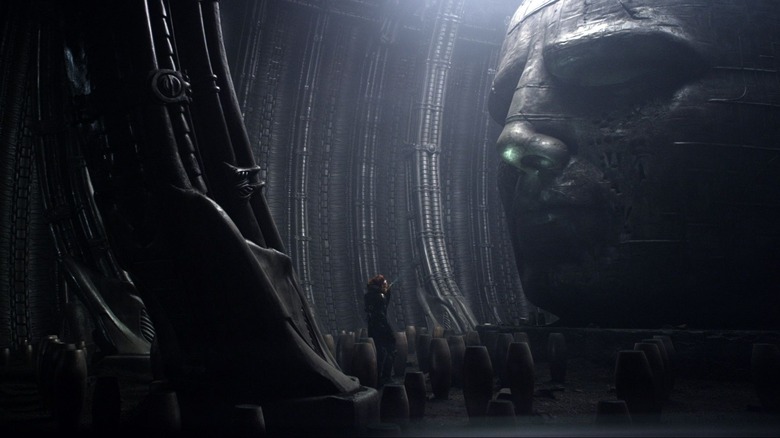Why Xenomorphs Are Obsessed With Killing Humans
In Ridley Scott's 1979 film "Alien," the sinister android Ash (Ian Holm) describes the killer creature loose aboard his spaceship as "the perfect organism," admitting that its "structural perfection is matched only by its hostility." He also says that he admires its purity. The alien is "a survivor, unclouded by conscience, remorse, or delusions of morality." Little else is revealed about the xenomorphs in that original film, with the murderous alien remaining very, well, alien. The one detail that Ash seems to drop is that the creature could be harvested as an invasive species intended for combat purposes.
The notion that the xenomorphs are a pure destructive force — a life-form that only exists to take lives — is one that runs throughout multiple "Alien" sequels. In James Cameron's 1986 follow-up "Aliens," for instance, Paul Reiser plays a suspicious wonk for a mysterious company that aims to gather and weaponize one of that film's many monsters. That film proves that no military force, no matter how confident or well-equipped, will be able to stand up to the xenomorphs. "Aliens" also introduced the notion that the xenomorphs were a naturally pervasive, semi-intelligent species that are born of an insect-like queen. This stands in opposition to a deleted scene from "Alien" wherein a xenomorph transforms singular victims into eggs.
David Fincher's troubled "Alien³" and Jean-Pierre Jeunet's whimsical "Alien Resurrection" each took the series in its own direction, with one being a delightfully depressive look at the futility of fighting a pervasive and undying alien death machine, and the other being a kooky "Aliens" riff full of goop, clones, and creatures. It wouldn't be until Scott returned to the series in 2012 with "Prometheus" that the true function of the xenomorphs would be revealed.
Prometheus is a Christmas movie
"Prometheus" takes place many years before the events of "Alien," and involves no common characters. It also ignores all of the continuity laid out by all the films made since 1979, including the pair of movies where xenomorphs engaged in fisticuffs with Predators. "Prometheus" begins millions of years in the past with an enormous, white-skinned Adonis — an Engineer — drinking a mysterious black substance on a primordial Earth. The alien's body breaks down, its DNA seeding Earth's waters. Fast-forward to the year 2089, and a group of space explorers have found a cave painting on Earth that may clue them in to the origins of the planet. They trek out into the galaxy with a very human-like android, and land on a planet called LV-223.
On LV-223, the astronauts discover an enormous, mysterious alien edifice that contains a host of mysteries. They find a dead alien body and Lovecraftian chambers — some similar to the one seen in "Alien" — full of unusual, ancient amphorae. Through various misadventures, the crew learns that the planet is chock full of unguents and spores that infect human bodies, impregnate their abdominal chambers, and spawn any number of destructive animal species. Eventually, the lead astronaut Shaw, a Christian character played by Noomi Rapace, surmises that the large white-skinned Engineers artificially grew a killer menagerie specifically to be let loose on Earth. Given the amount of time it takes for information to travel from Earth to LV-223, she finds that the Engineers began their project some 2053 years before.
And what significant Christian event occurred on Earth back in A.D. 33? And how does that relate to the fact that "Prometheus" also takes place at Christmastime?
Space Messiah
Ridley Scott seems to heavily imply that Jesus of Nazareth was, in fact, an Engineer. Just as humankind's ultimate creator was an Engineer who sacrificed his body in a river, so too was Jesus. It seems that Jesus was a being sent to Earth to check up on this little human experiment that the Engineers had been running for the past 3.7 billion years. One might even extrapolate that the Messiah Engineer was sent to Earth to spread a philosophy of pacifism and togetherness. When humans rejected those philosophies by crucifying the visiting Engineer, the rest of our alien overlords declared us a failure and began making organic weapons to wipe us out.
In so doing, however, they lost control of their creatures and were wiped out themselves. This proves to be doubly true when the android David (Michael Fassbender) hijacks an alien craft and uses the Prometheus spores to lay waste to the Engineer homeworld in "Alien: Covenant." The Engineers made humans, were upset with the result, and tried to make monsters to kill us. We, meanwhile, made suspicious androids obsessed with purity, and our own creations wiped out our creators. The levels of meaning are myriad.
"Prometheus" ambitiously attempts to blend science with the divine, all using iconography from Scott's 1979 creature feature. The aliens were, effectively, demons. Living weapons that only serve to kill. It's why they were made. That is why they are obsessed with killing humans. It's in their very DNA. "Prometheus" owes more to the heady, semi-theological sci-fi of "2001: A Space Odyssey" than the military mayhem of "Aliens."
The Drake equation
If one wants to take a daring gander into the extended universe of "Alien," one will find that Marvel Comics began a new title based on "Alien" in 2021. In the sixth issue of that series, an android pointed out that the xenomorphs were made for a different purpose than divine revenge. An android refers to the animals as "Prometheus' cleansing fire," implying that the aliens are used regularly to wipe out great swaths of living beings. The xenomorphs are used to keep any and all sentient creature populations at bay.
Why are there so many living extermination tools? While the comic book does not answer that question, it does explain a great mystery about the galaxy summed up by the Drake Equation and the Fermi Paradox. The equation, named by Dr. Frank Drake in 1961, is a means to calculate the probability of other intelligent species in the galaxy. Given the sheer number of stars, it seems probable that human-like life would inhabit other worlds. The Fermi Paradox, however, posits that if life can so easily evolve on other worlds, it stands to reason that at least one alien species would have invented interstellar travel by now and come to visit us. Indeed, it's illogical that they haven't.
If, however, there is a species of genetically engineered monsters in the mix — and one that was bred specially to wipe out other species — then it would explain why no one alien species ever meets another. As soon as one species takes to the stars, xenomorphs appear to kill them all. Then, once sated, the xenomorphs return to a dormant state in eggs until the next time around.
With xenomorphs in the mix, the Fermi paradox is solved!



